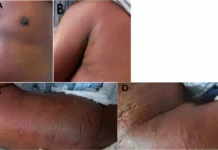Case of 4-year-history of penile fibroepithelial polyp in 73-year-old patient with no significant medical history.
A 73-year-old male patient presented with a 4-year-history of a painless penile mass that had been gradually increasing in size. A diagnosis of penile fibroepithelial polyp was made.
The patient’s history revealed that he had urinary urge incontinence for the last 17 years after a spinal surgery. Therefore, since then the patient was using a condom catheter. The growth of the mass accelerated over the 4 months and it became more difficult for the patient to have good hygiene. In addition, the condom did not fit anymore because of the size of the mass. For this reason he started to design special plastic bags for this purpose. The mass itself was foul smelling. Other symptoms included bilateral lower limb weakness following the spine surgery, stool incontinence and erectile dysfunction.
On the contrary, the patient had a good urinary stream with no dysuria or hematuria. He had no other similar skin lesions and did not undergo any previous penile surgeries, other than circumcision during childhood. He did not have a recent travel history. In addition, denied using any penile vacuum devices or constructive rings. There was no trauma history. Nor was he taking any medications.
Examination and diagnosis
Examination showed a huge, non tender, grape-like penile firm mass measuring 15 x 10 x 8 cm which originated from the glans penis and ventral aspect of the penile shaft. The lesion had a broad base with no stalk. There was no ulceration or discharge from the lesion. Both testicles, scrotal skin and meatal opening were normal. Inguinal lymph nodes were not palpable. In addition, there were no other skin lesions anywhere else on his body.
Urine analysis and culture were positive for urinary tract infection. CT scan of the urinary tract showed bilateral mild hydroureteronephrosis. Moreover, a Foley’s catheter was inserted and kept in situ. Doctors prescribed antibiotics and intravenous fluids. Cystourethroscopy showed a normal urethra, an enlarged prostate and trabeculations of the urinary bladder. Histopathology showed a benign fibroepithelial polyp with no signs of malignancy.
Treatment included partial panectomy. The whole mass was excised under general anaesthesia. Since the lesion had a very broad base, it was not possible to preserve the penis. The patient had an uneventful recovery with no signs of recurrence in follow-up for two years.
References
A Huge Penile Fibroepithelial Polyp Treated with Partial Penectomy: A Case Report and Review of the Literature https://www.ncbi.nlm.nih.gov/pmc/articles/PMC7495161/




